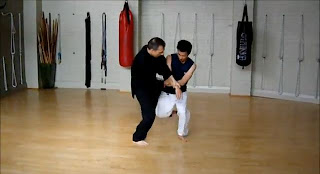The ikkyo "projection" and its internal counterpart

Introduction In this article I will analyse one of my favourite "projections" (or throws) and one that I most frequently apply in sparring. The term "ikkyo" means, literally, "first lesson" in Japanese. Students of aikido will know it as a foundational technique that leads them on to "nikkyo", "sankyo" and "yonko" (second, third and fourth lessons respectively) as well as many other techniques. In essence, ikkyo, like its related techniques, is a compound "lesson" teaching the student the following: a "projection" by which leverage on a joint can lead the body to be "projected" in a particular direction (think of it as a kind of "throw"); and a pin that takes place on the ground once the "uke" (your partner/opponent) is "projected" (thrown). This article will deal with only the first portion: the projection. I shall deal with the ground pin on another day. I prop...

